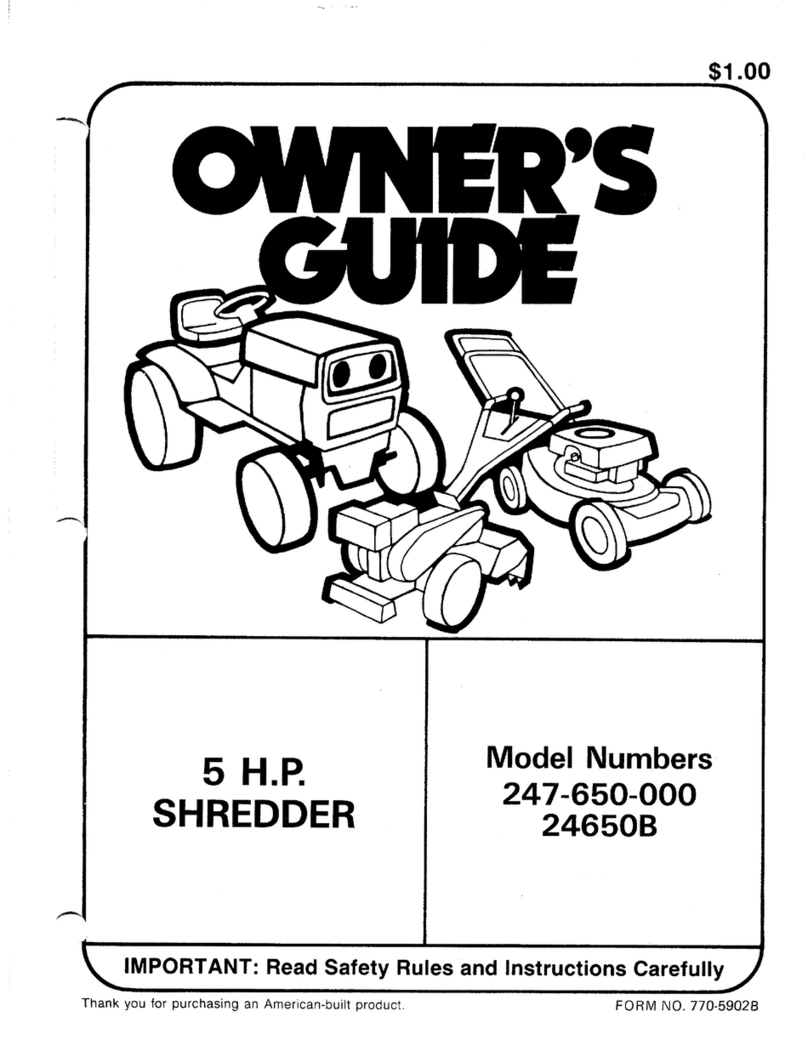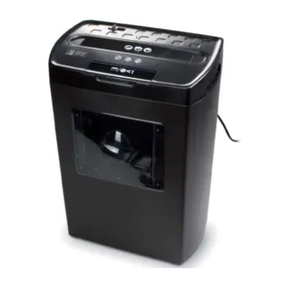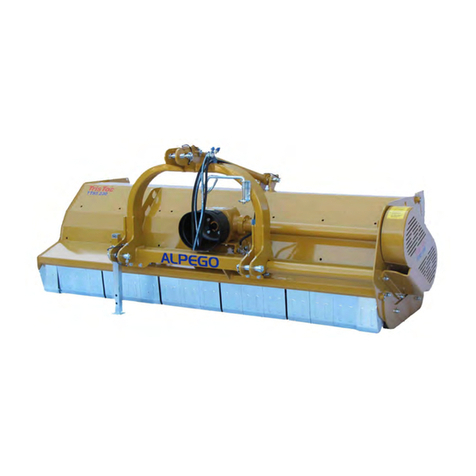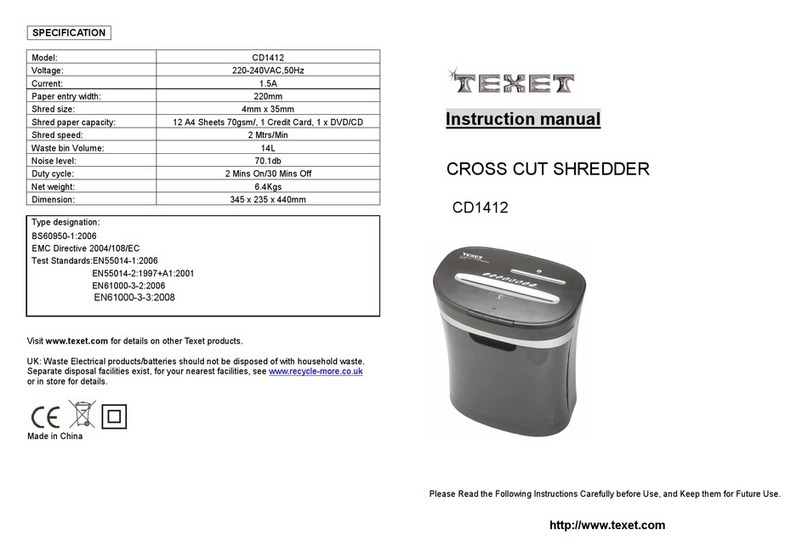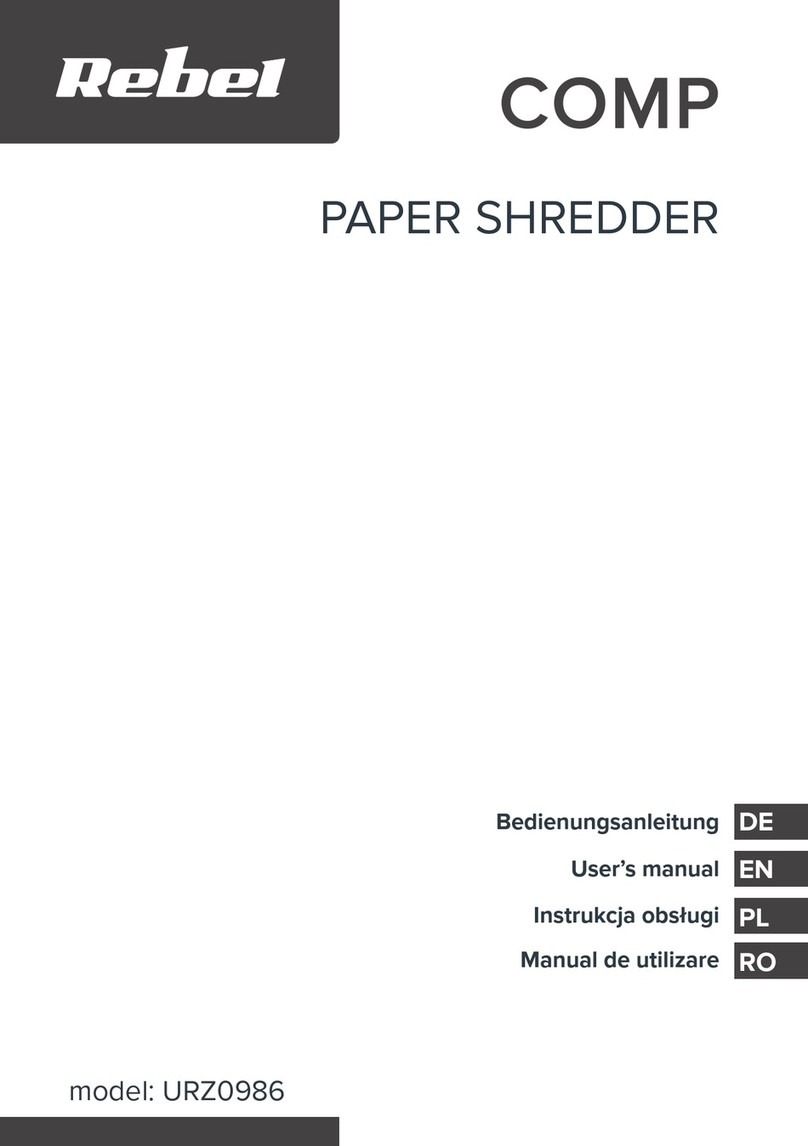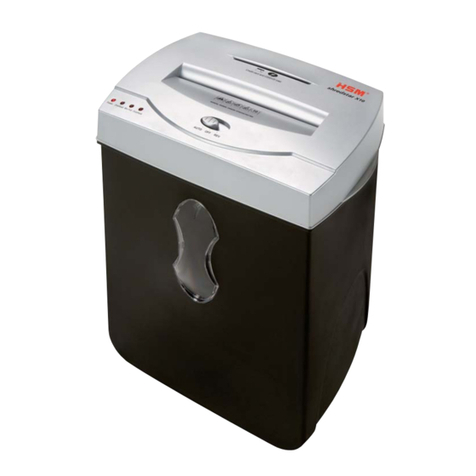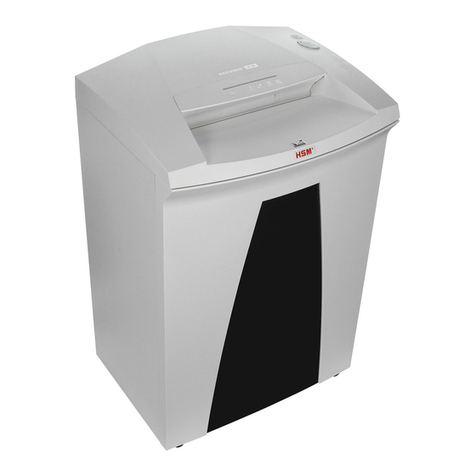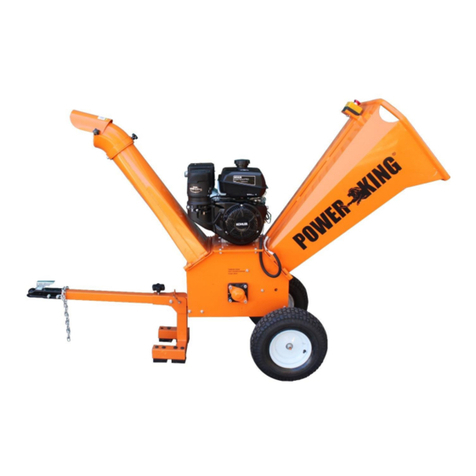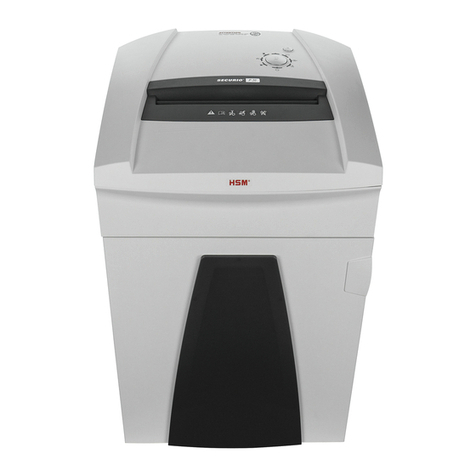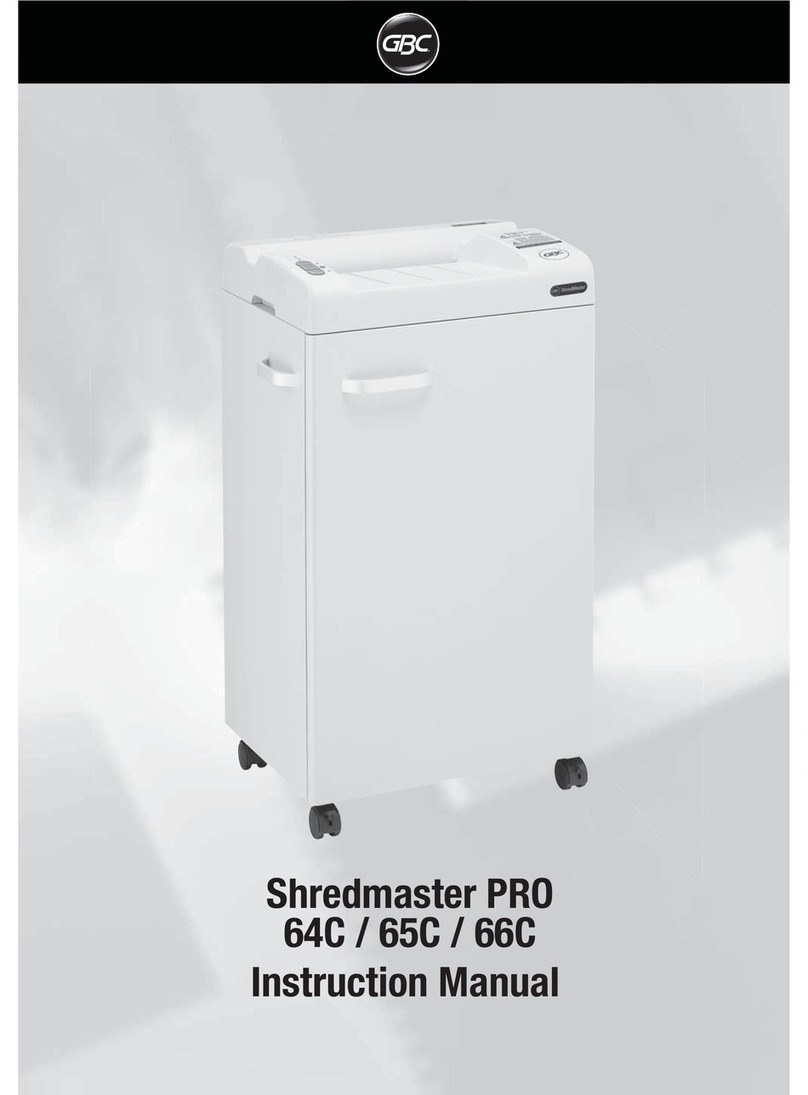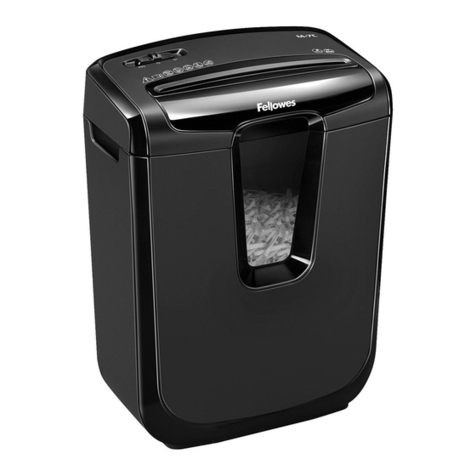EFCUT MF30 User manual

MF30 Chipper Shredder
Instruction Manual
WARNING:
Read carefully and understand all INSTRUCTIONS before operating. Failure to follow the safety rules
and other basic safety precautions may result in serious personal injury.
Save these instructions in a safe place and on hand so that they can be read when required. Keep
these instructions to assist in future servicing.
Rev.1.1

WARNING SYMBOL
Do not allow children to operate this chipper shredder. Keep small children away from
the area while chipper shredder is in use. Do not allow adults to operate the chipper
shredder without proper instruction.
WARNING SYMBOLS AND DEFINITIONS
DANGER
DANGER INDICATES A SERIOUS INJURY OR FATALITY WILL RESULT
IF THE SAFETY INSTRUCTIONS THAT FOLLOW THIS SIGNAL WORD
ARE NOT OBEYED.
WARNING
WARNING INDICATES A HAZARD WHICH, IF NOT AVOIDED, COULD
RESULT IN DEATH OR SERIOUS INJURY AND/OR PROPERTY
DAMAGE.
CAUTION
CAUTION INDICATES YOU CAN OR YOUR EQUIPMENT CAN BE HURT
IF THE SAFETY INSTRUCTIONS THAT FOLLOW THIS SIGNAL WORD
ARE NOT OBEYED.
IMPORTANT
IMPORTANT INDICATES HELPFUL INFORMATION FOR PROPER
ASSEMBLY, OPERATION, OR MAINTENANCE OF YOUR EQUIPMENT.
Intended Use
Foreseeable Misuse
This is a petrol engine-powered chipper shredder that breaks up leaves and wooded
pieces such as tree branches, brush, and limbs into smaller volume via a high-speed
rotor containing chipping blades and shredding hammers. It shall not be used for any
other purpose.
WARNING
1.
You must read, understand and comply with all safety and operating instructions in
this manual before attempting to setup and operate your chipper shredder.
2.
Failure to comply with all safety and operating instructions can result in loss of
machine control, serious personal injury to you and/or bystanders, and risk of
equipment and property damage. The triangle in the text signifies important
cautions or warnings which must be followed.
WARNING
1.
Engine exhaust, wood dust, and gasoline vapors from this product contains
chemicals known to the state of California
2.
To cause cancer, birth defects, or other reproductive harm.
WARNING:
This
is the
warning
symbol
to
get your
high
attention
for the instruction
notice,
which
should
be
followed
to
avoid the
potential
serious personal
injury.
Anyone
to
use this equipment
should
read
all
the instructions
of
this manual. Keep this
instruction manual for future reference.

1
Chipper
Cone
Discharge
Chute
Wheel
INDEX
Features ---------------------------------------------------------------------------------------------------------------------------------------- 1
Specifications --------------------------------------------------------------------------------------------------------------------------------- 1
Safety ------------------------------------------------------------------------------------------------------------------------------------------ 2-4
Assembly --------------------------------------------------------------------------------------------------------------------------------------- 5
Operation ------------------------------------------------------------------------------------------------------------------------------------- 6-7
Transportation and Storage ------------------------------------------------------------------------------------------------------------ 7-8
Maintenance --------------------------------------------------------------------------------------------------------------------------------- 8-9
Trouble Shooting --------------------------------------------------------------------------------------------------------------------------- 10
Repair ------------------------------------------------------------------------------------------------------------------------------------------- 11
Parts Breakdown ---------------------------------------------------------------------------------------------------------------------- 12-14
Warranty --------------------------------------------------------------------------------------------------------------------------------------- 14
OPTIONAL ACCESSORY ------------------------------------------------------------------------------------------------------------ 15-16
FEATURES
Shredder Hopper Handle
Engine
Stand
Rotor
Housing
Vacuum
Inlet
SPECIFICATIONS
Engine Specifications
Engine Brand Rato
Engine Type OHV
Power 7HP
Displacement 212CC
Starting Recoil
RPM 3600
Fuel Capacity 0.7Gal
Oil 10W-30 for 32°F & above
5W-30 for 25°F & below
EPA3 Approval Yes
CARB Approval Yes
Item
No.
MF30
Chipping
Capacity
Max.
3”
Shredder Capacity 1/2”
Chipping
Knives 2
Shredder Hammer 4 Y-hammers
Reduction
Rate 15:1
Chipper Knife
Material High Speed Steel
Hopper Dimensions (IN) 19.3 x 13
Limb
Chute
Yes
Wheel Size (IN)
10x3
Wheel
Material PU
Wheel Type
Solid
Net
Weight
(LB) 123
Gross
Weight
(LB) 136
Assembled
Dimension (IN)
27.5 x 27.5 x 39.4
Packing Dimension (IN)
33 x 26 x 22

2
GENERAL OPERATING SAFETY
1.
Read, understand, and follow all instructions in the manual and on the unit before starting
2.
Locate the Chipper/Shredder on a flat, level, sturdy surface capable of supporting the weight of the Chipper /
Shredder and any additional tools and equipment.
3.
Do not attempt to use the machine on a slope or slick surface.
4.
Dress appropriately when operating the chipper shredder. Always wear sturdy footwear and safety goggles.
Never wear sandals, sneakers or open shoes, and never operate the chipper shredder with bare feet. Do not
wear loose clothing that might get caught in moving parts.
5.
Never place your hands, fingers, feet, or any other part of your body close to the Discharge Opening while the
Chipper/Shredder is in operation.
6.
Do not look into the Hopper, Chipper Chute or Discharge Opening when the machine is running.
7.
Only allow responsible adults, who are familiar with the instructions, to operate the unit. Keep children away from
the equipment, especially while it is operating.
8.
Be sure the area is clear of other people before operating. Stop the unit if anyone enters the area.
9.
Always maintain secure footing and solid balance while starting or operating the chipper shredder. Never lean
directly over the machine.
10.
Operate the machine only in daylight or good artificial light.
11.
Do not operate the unit while under the influence of alcohol or drugs.
12.
Always wear eye and hearing protection when operating this unit.
13.
Keep in mind the operator is responsible for accidents occurring to other people or property.
14.
Never operate the machine without proper guards, plates, or other safety protective devices in place.
15.
Thoroughly inspect where equipment is to be used and remove all foreign objects.
16.
Exercise extreme caution when operating on or crossing gravel drives, walks or roads. Stay alert for hidden
hazards or traffic.
PRODUCT SPECIFIC SAFETY
DANGER: The chipper shredder has spinning blades that can amputate hands and
feet. Do not place hands or feet in the hopper or chipper cone, or discharge chute.
WARNING: This unit discharges debris at high speeds. Always wear protective
goggles and do not operate without the debris bag in place.
Do not allow anyone in the area while the unit is running. If someone does enter the area, shut the unit off immediately
until they leave. Organize the work area prior to starting work.
1.
Do not operate without the debris bag in place because this unit discharges debris at high speeds. If the unit is
operated on hard ground, asphalt, concrete, or other hard surfaces without the collection bag in place. Material
can ricochet off of the hard surface and cause an unsafe condition for users and bystanders.
2.
Never leave the machine running unattended. Always turn off the engine, wait for the rotor to come to a
complete stop, and disconnect the spark plug before leaving the area. Always move the unit to a safe storage
area when not in use.
3.
Never direct discharge material toward anyone. Avoid discharging material against a wall or obstruction. Material
may ricochet back toward the operator.
4.
Always stand to the side of the chipper cone when feeding tree limbs and branches into the unit, as tree limbs,
branches, and harder woods may kick back while being chipped.
5.
Always keep hands out of the chipper cone and shredder hopper when feeding materials. Never wrap fingers
tightly around branches as you are feeding them into the unit, as a sudden inward surge could pull your hands
and arms into the unit.
6.
Never allow material to build up in the discharge area or shredding chamber, as this may cause new material
being fed into the machine to kickback with sufficient force to injure you or other bystanders.
7.
Never allow material to build up around the engine during chipper shredder operation. This could result in a fire,
or overheating of the engine.

3
8.
Never attempt to reposition or move the chipper shredder unit while it is running. Doing so could cause the
machine to tip over, and reaching to steady the unit could result in accidental insertion of your hands into the
chipper cone or shredder hopper areas.
9.
Never continue to operate the machine if it starts making unusual noise or vibration. Shut the engine off
immediately, allow the rotor to stop, disconnect the spark plug wire and secure the wire away from the spark
plug. Inspect the unit for any signs of damage or foreign material in the chipping or shredding areas. Remove
any solid material that may be preventing the unit from operating properly.
10.
Never attempt to clear clogs from the chipper cone, shredder hopper or discharge chute while the unit is
running. Always shut the engine off, allow the rotor to come to a complete stop, and remove the spark plug wire
from the spark plug before removing excess materials.
11.
Never attempt to perform any maintenance, repairs, or attachment of accessories while the unit is running.
Always shut the unit off, allow the rotor to come to a complete stop, and remove the spark plug wire from the
spark plug before beginning these activities.
12.
Always make sure that the shredding chamber, shredder hopper, and chipper cone are empty before starting
the unit after it has been idle. Attempting to start the unit with material in these areas could cause the engine
starting cord to stop suddenly, injuring your hand and fingers, or toppling the unit over. Vibration is generally a
warning sign of trouble.
13.
Use only attachments and accessories approved of by the manufacturer of the machine.
14.
Make sure chipper shredder is free of debris before starting the engine.
15.
Never attempt to make any adjustments while the engine is running.
16.
After striking a foreign object, stop the engine, remove spark plug wire, and wait for all moving parts to come to
a complete stop. Thoroughly inspect the machine for any damage, repair the damage before restarting and
operating the machine.
ENGINE SPECIFIC SAFETY
Before cleaning, repairing, or inspecting, shut off the engine and make certain that all moving parts have come to a
complete stop. Disconnect the spark plug wire and secure the wire away from the spark plug to prevent accidental
starting.
DANGER
1.
Engines give off carbon monoxide, an odorless, colorless, poison gas. Carbon monoxide may be
present even if you do not smell or see any engine exhaust. Breathing carbon monoxide can cause
nausea, fainting or death, in addition to drowsiness, dizziness and confusion. If you experience any of
these symptoms, seek fresh air and medical attention immediately.
2.
If your machine comes with a separate engine manual, be sure to read and follow all safety and warning
precautions outlined there, in addition to any in this manual.
Handle fuel with care; it is highly flammable.
a.
Use an approved fuel container.
b.
Never add fuel to a running engine or hot engine.
c.
Fill fuel tank outdoors with extreme care. Never fill fuel tank indoors.
d.
Replace gasoline cap securely and clean up spilled fuel before restarting.
Preventing Carbon Monoxide Poisoning
1.
Always start and run engine outdoors. Do not start or run engine in an enclosed area, even if doors or windows are open.
2.
Never try to ventilate engine exhaust indoors. Carbon monoxide can reach dangerous levels very quickly.
3.
Never run engine outdoors where exhaust fumes may be pulled into a building.
4.
Never run engine outdoors in a poorly ventilated area where the exhaust fumes may be trapped and not easily
taken away. (Examples include: in a large hole or areas where hills surround your working area.)
5.
Never run engine in an enclosed or partially enclosed area. (Examples include: buildings that are enclosed on
one or more sides, under tents, car ports or basements.)
6.
Always run the engine with the exhaust and muffler pointed in the direction away from the operator.
7.
Never point the exhaust muffler towards anyone. People should always be many feet away from the operation of
the engine and its attachments.
8.
Do not change the engine governor settings or over-speed the engine.
9.
Do not operate the engine in a confined space where dangerous carbon monoxide fumes can collect.

4
Gasoline Fires and Handling Fuel Safely
Use extra care in handling gasoline and other fuels. They are flammable and vapors are explosive.
1.
When storing extra fuel be sure that it is in an appropriate container and away from any fire hazards.
2.
Prevent fire and explosion caused by static electric discharge. Use only nonmetal, portable fuel containers
approved by the Underwriter’s Laboratory (U.L.) or the American Society for Testing &Materials.
3.
Always fill fuel tank outside in a well ventilated area. Never fill your fuel tank with fuel indoors. (Examples
include: basement, garage, barn, shed, house, porch, etc.) Never fill tank near appliances with pilot lights,
heaters, or other ignition sources. If the fuel has to be drained, this should be done outdoors. The drained fuel
should be stored in a container specifically designed for fuel storage or it should be disposed of carefully.
4.
Never remove the fuel cap or add fuel with the engine running. Stop engine and allow to cool before filling.
5.
Do not smoke while refueling or operating engine.
6.
Never drain fuel from the engine in an enclosed area.
7.
Always wipe up excess (spilled) fuel from engine before starting. Clean up spilled fuel immediately. If fuel is
spilled, do not start the engine but move machine and fuel container from area. Clean up spilled fuel and allow to
evaporate and dry after wiping and before starting.
8.
Allow fuel fumes/vapors to escape from the area before starting engine.
9.
Test the fuel cap for proper installation before starting and using engine.
10.
Always run the engine with fuel cap properly installed on the engine.
11.
During storage, keep machine so gas cap is up.
12.
Never siphon fuel by mouth to drain fuel tank.
13.
Always have an adult fill the fuel tank and never allow children to fill the engine.
14.
Never allow an adult or anyone under the influence of drugs or alcohol to fill engine.
15.
When storing gasoline or equipment with fuel in the tank, store away from furnaces, stoves, water heaters or
other appliances that have a pilot light or other ignition source because they can ignite gasoline vapors.
16.
Never fill containers inside a vehicle or on a truck bed with a plastic bed liner. Always place containers on the
ground away from your vehicle before filling.
17.
Remove gas-powered equipment from the truck or trailer and refuel it on the ground. If this is not possible, then
refuel such equipment on a trailer with a portable container, rather than from a gasoline dispenser nozzle.
Burns and Fires
The muffler, muffler guard and other parts of the engine become extremely hot during the operation of the engine.
These parts remain extremely hot after the engine has stopped.
Prevention of Burns and Fires
1.
Never remove the muffler guard from the engine.
2.
Never touch the muffler guard because it is extremely hot and will cause severe burns.
3.
Never touch parts of the engine that become hot after operation.
4.
Always keep materials and debris away from muffler guard and other hot parts of the engine to avoid fires.
Children and Bystanders
Tragic accidents can occur if the operator is not alert to the presence of children and/or bystanders. Never assume
that others will remain where you last saw them.
1.
Keep the area of operation clear of all persons, especially small children and pets. Keep children under the
watchful care of a responsible adult.
2.
Be alert and turn the machine off if children enter the area.
3.
Before and while moving backwards, look behind and down for small children.
4.
Never allow children to operate the machine

5
ASSEMBLY
Install Wheel Rack (See Figure 1)
1.
Position the wheel rack (A) underneath the
housing (B)
2.
Using three flange bolt (C), marked with R1, and
three nuts (D) to tight the wheel rack with the
housing
Install the Wheels (See Figure 2)
1.
Put the wheel (A) onto the axle (B), Make sure the
wheel disc flat side face to machine.
2.
Insert the cotter pin (C), marked with R2, into the
hole to secure the wheel on the axle, open the
two pins.
Install the Stand (See Figure 3)
1.
Position the stand (A) underneath the engine
base
2.
Using four flange bolt (B) and nut (C), both
marked with R3, to tight the stand with the
engine base
Install the Handle (See Figure 4)
1.
Position the handle(A) to by aligning the handle holes
on the both sides of hopper (B)
2.
Using four flange bolts (C) and nuts (D), marked with
R4, to secure the handle on the hopper
Figure 1 Figure 2
Figure 3 Figure 4

6
Fi
g
ure 6
Install the Hopper (See Figure 5)
1.
Set damper plate (B) and U shape plate (C) onto
housing (D) by aligning through the aligned holes
2.
Assembly the U shape plate (C), put hopper (A)
onto U shape plate (C)
3.
Position the hopper (A)
by aligning the
assembly holes and fix
by bolts (E)
4.
Tight nuts (F) to secure
the guard assembly
to the hopper
Install the Chipper Cone (See Figure 6)
1.
Set chipper cone (B) to the three outstanding bolts
(D) on housing
2.
Tight three flange nuts (C) to secure shipper cone
(B)
NOTE: must put cone cap (A) on before use
vacuum kit to collect leaves.
Figure 5
BAG ASSEMBLY
(See Figure 7)
1. Open adjustable discharge guard (A) and lock open with locking nut.
2. Place opening of the bag (B) around discharge chute (C)
and fasten to housing using draw string on the bag.
Adding Oil
(See Figure 8)
You must add oil to the machine
before starting, oil can be added in
either of the two spots located at the
bottom rear of the machine, there is one each
side. (See page 1 for oil type)
Figure 8
Figure 7

7
DANGER
1.
The exhaust from this product contains carbon monoxide gas. Carbon monoxide is a colorless, odorless and
tasteless gas that can cause dizziness, nausea, unconsciousness or even brain damage and death if inhaled for
prolonged periods.
2.
Operate the unit outdoors in a well ventilated location only. Keep children, pets and bystanders away.
3.
Failure to follow these instructions may result in serious injury or death.
WARNING
1.
Gasoline is highly flammable and must be handled with care. Never fill the tank when the engine is still hot from
recent operation.
2.
Do not allow open flame, smoking or matches in the area. Avoid over-filling and wipe up any spills.
WARNING: To avoid serious personal injury from rotating cutting blades, keep
hands out of inlet while machine is running.
WARNING: Do Not Use Gasoline Containing Methanol, Gasohol Containing More
Than 10% Ethanol, Gasoline Additives Or White Gas Because Engine/fuel System
Damage Could Result.
IMPORTANT: Engine is shipped from factory without oil. You must add engine oil
before starting engine.
Adding Fuel
To add fuel:
1.
Remove the fuel cap.
2.
Fill the tank. Do not overfill. Leave room in the tank for fuel expansion. Refer to your engine manual for specific fuel
recommendations.
3.
Install and hand tighten the fuel cap.
Starting the Engine
1.
See engine manual for starting up instructions.
2.
Ensure engine is running full throttle before beginning chipping operation. On some engines, the throttle may not
be adjustable.
Stopping the Engine
1.
See engine manual for shut down procedure.
2.
Stopping the engine is the only way to stop the rotor from turning. With engines equipped with an adjustable
throttle, move the throttle to the SLOW position and wait for engine to be running a slow RPM. Then switch to
STOP ENGINE as shown in the engine manual.
TRANSPORTING AND STORAGE
1.
Always observe safe refueling and fuel handling practices when refueling the unit after transportation or storage.
2.
Never store the unit (with fuel) in an enclosed poorly ventilated structure. Fuel vapors can travel to an ignition
source (such as a furnace, water heater, etc.) and cause an explosion. Fuel vapor is also toxic to humans and
animals.

8
3.
Always use the hopper handle and built-in wheels to move the chipper shredder. Never lift the unit using the fuel
tank for support. If the unit must be lifted , always use at least two people, and always grip the unit securely
using the front leg and hopper handle.
4.
Always follow the engine manual instructions for storage preparations before storing the unit for both short and long
term periods.
5.
Always follow the engine manual instructions for proper start-up procedures when returning the unit to service.
6.
Never store the unit or fuel container inside where there is an open flame or pilot light, such as in a water heater.
Allow unit to cool before storing.
Storage
Perform engine maintenance and storage measures listed in the engine owner’s manual. This includes draining the
fuel system, or adding stabilizer to the fuel. NOTE: Do not store a fueled unit in an enclosed structure. (SEE
GASOLINE FIRES AND HANDLING FUEL SAFETY)
Before starting the unit after it has been stored:
1.
Check all fluid levels. Check all maintenance items.
2.
Perform all recommended checks and procedures found in the engine owner’s manual.
3.
Allow the engine to warm up for several minutes before use.
MAINTENANCE
Schedule & Procedures
The following schedule should be followed for normal care of your unit.
SAFETY ITEMS
BEFORE
EACH USE
EVERY
5 HOURS
EVERY
25 HOURS
EVERY
100 HOURS
EVERY
250 HOURS
SPRING
& FALL
Check for loose hardware X X
Check all safety labels X
Inspect cone, hopper, and guards X X
CHIPPER MAINTENANCE ITEMS
Clean debris from engine and chipper X
Inspect/Rotate Shredding Hammers X
Inspect/Rotate Chipping Knives X
Engine Maintenance
Refer to the engine manual included in your package for information on engine maintenance. Your engine manual
provides information and a maintenance schedule for performing the following tasks:
1.
Always check oil level before starting engine. Refer to engine manual for capacity and type of oil to use.
2.
Change oil after first 5-8 hours of operation. Change oil while engine is warm. Refill with new oil of recommend-
ed grade.
4.
Check spark plug yearly or every 50 hours of operation.
5.
Service air cleaner.
6.
Keep engine and parts clean.
7.
Check engine and equipment often for loose nuts and bolts, keep these items tightened.
Check for Loose Hardware
1.
Service Interval: Every 5 hours; every spring and fall.
2.
Inspect the unit, checking for loose hardware or components.
3.
Pay special attention to the hardware attaching the chipper cone, hopper, axle, and front leg.

9
Check Safety Labels
1.
Service Interval: Every spring and fall.
2.
Check that the safety labels are in place and undamaged.
3.
Sample illustrations and part numbers of the decals can be found on page 6. Replace any damaged or missing
decals.
Inspect Cone, Hopper, & Guards
1.
Service Interval: Every spring and fall.
2.
Check that the chipper cone, shredder hopper, and discharge guards are in place, undamaged, and secure.
Replace any damaged or missing parts.
Clean Debris from Engine & Chipper
1.
Service Interval: Before each use and every 100 hours.
2.
The engine requires air flow to cool itself and for combustion.
3.
Before each use, clean any debris from the unit especially from around the air shroud intake, air filter, and
muffler. Every 100 hours, remove the engine air shroud and clean out any debris from the engine cooling fins.
We recommend having this service performed by an authorized dealer.
Inspect / Rotate Shredding Hammers (See Figure 9)
Service Interval: Every 25 Hours, or As Necessary
The shredding hammers of this unit can be rotated to
provide a new cutting surface as required. The Y
hammers can be flipped over once. To inspect the
shredding hammers:
1.
Disconnect the spark plug wire and secure it away
from the spark plug.
2.
Remove the small circular access panel (B) from the
back of the shredder housing. SEE FIGURE 9
3.
Inspect the cutting edges of the Y-hammers (A).
Inspect Chipping Knives (See Figure 10)
Service Interval: Every 25 hours, or as necessary
The chipping knives of this unit can be rotated or
sharpened to provide a new cutting surface as
required. When inspecting the knives be careful to
avoid touching the sharpened edges. To inspect the
chipping knives:
1.
Disconnect the spark plug wire and secure it away
from the spark plug.
2.
Remove the nuts securing the chipper cone to the
front of the chipper. Remove the chipper cone to
access the knives. SEE FIGURE 10
3.
Using the recoil starter, slowly pull the starter rope to
rotate the rotor into position so the blades can be
seen. To sharpen or replace the chipper knives, see
the Troubleshooting and Repair section.
Fi
g
ure
9
Figure 10

10
IMPORTANT: Engine is shipped from factory without oil. You must add engine oil
before starting engine.
CAUTION
1.
For the safety of the user, and to maximize the life of the engine, it is crucial to take time to check the condition
of the engine.
2.
Problems must be corrected before operating.
3.
Avoid injury! Engine oil is hazardous to your health. Dispose of oil appropriately.
4.
Use a safe disposal/recycling center.
TROUBLESHOOTING CHART
1.
While normal care and regular maintenance will extend the life of your equipment, prolonged or constant use
may eventually require that service be performed to allow it to continue operating properly.
2.
The troubleshooting guide below lists the most common problems, their causes, and remedies.
3.
See the information on the following pages for instructions on how to perform most of these minor adjustments
and service repairs yourself. If you prefer, all of these procedures can be performed for you by your local
authorized dealer.
WARNING
1.
To avoid serious injury, perform maintenance on the unit only when the engine is stopped.
2.
Always disconnect the spark plug wire and fasten it away from the plug before beginning the maintenance, to
prevent accidental starting of the engine.
Problem(s) Possible Cause Corrective Action
Engine won't start
1.
No fuel.
2.
Choke not in START position.
3.
Low quality or deteriorated, old gasoline.
4.
Dirty fuel passageways.
5.
Spark plug cap not connected securely.
6.
Spark plug fouled.
7.
No compressions. Problem after long storage
periods.
8.
Low engine oil.
1.
Add fuel.
2.
Turn choke to START position.
3.
Use fresh unleaded gasoline.
4.
Clean out passageways using fuel additive.
Heavy deposits may require further cleaning.
5.
Connect spark plug cap properly.
6.
Remove spark plug. Clean/replace as
recommended in engine manual.
7.
Lubricate the cylinder, pour tablespoon of oil
into spark plug hole. Crank engine a few times
and try to start again.
8.
Add engine oil to proper level.
Engine exhaust is black
1.
Dirty air filter.
2.
Choke closed.
1.
Replace air filter.
2.
Open choke.
Engine stops suddenly
1.
Fuel tank empty or full of impure or low quality
gasoline.
2.
Low oil shutdown.
3.
Disconnected or improperly connected spark
plug cap.
4.
The limb is too long.
1.
Add fuel tank with fresh unleaded gasoline.
2.
Fill engine oil to proper level.
3.
Secure spark plug cap.
4.
If the limb diameter for the side chute in 2"-3"
and the length over 31" long, suggest the
operator should help the limb feeding by
slightly holding to keep the rotate speed.
Engine runs but no
material is discharged
1.
Discharge chute clogged.
2.
Engine not running at full speed.
1.
Clean out debris.
2.
Set throttle control to FAST if equipped.
Chipping action slow,
or engine stalling
1.
Branch diameter is too thick.
2.
Throttle set is too slow.
3.
Tree limbs are extremely hard or dried out.
1.
Do not process branches over 3" diameter.
2.
Adjust throttle to increase engine speed.
3.
Material is not suitable for chipping.
Unusual noise or
vibration when
chipping material
1.
Rotor overloaded with material.
2.
Hammers are broken, bent, or loose.
3.
Hammers frozen in place.
1.
Allow unit to clear itself before adding more
material to the hopper.
2.
Check assembly. Tighten or replace as
necessary.
3.
Check for obstructions and debris. Repair or
replace as necessary.
Vacuum not working.
1.
Hopper gate not closed.
2.
Cone cover not installed.
3.
Hose not attached properly.
4.
Engine not running at full RPM.
1.
Slide gate to closed position.
2.
Allow material to dry.
3.
Clear blockage or replace.
4.
Set throttle control to FAST if equipped.

11
REPAIR
Shredding Hammer Rotation and Replacement
The cutting edges of the shredding hammers may eventually wear out requiring rotation of the hammer or
replacement if all cutting edges have been dulled.
To rotate the shredding hammers:
1.
Turn the engine off and wait for all moving parts to stop.
2.
Disconnect the spark plug wire and secure it away from the spark plug.
3.
Detach the rotor housing and hopper from the rotor plate. SEE FIGURE 11
4.
Note the assembly sequence of the hardware used to secure the hammers. Using an allen wrench remove the
socket head cap screw (1) and related hardware. SEE FIGURE 12
5.
Inspect the hammers (4), spacer tubes (5), and hardware. If the spacer tube (5) shows signs of wear, replace it.
Inspect and flip, or replace the hammers (4).
6.
Reassemble the hammers, spacers, washers, and cap screws.
Torque the socket head cap screws (1) back tightly
7.
Repeat for all the hammers.
Chipping Knives Sharpening and Replacement
1.
The chipping knives should be sharpened or replaced when tree limbs require extra force to feed into the chipper cone.
2.
The chipping knives may be sharpened at a 35 degree angle until the distance between the edge of the blade
bevel and the mounting hole is less than 2/5” (10.16mm). SEE FIGURE 13.
To inspect, sharpen, or replace the chipping knives:
1.
Turn the engine off and wait for all moving parts to stop.
2.
Disconnect the spark plug wire and secure it away from the spark plug.
3.
Remove chippercone(B)byunscrewthreenuts(A),SEEFIGURE13
4.
Remove removable cover of housing (E) by unscrew four bolts (C) and
four nuts (D),SEE FIGURE 14
5.
Using a 5 mm Allen wrench together with a 13mm spanner to unfix
chipper knife by unscrew bolt (9) and nut (7), before replacement, must
clean out all debris in the bolt (9) and nut (7), SEEFIGURE12
6.
Inspect, rotate, sharpen, or replace the chipper knife. SEE FIGURE 15
7.
Reinstall the chipper knife and tighten the bolts, secure removable
cover of housing (E) and chippercone(B),SEE FIGURE 14
Figure
15
–
Chipper knife minimum cutting edge
Figure 13
Figure
11
Figure
12
Figure
14

12
PARTS BREAKDOWN
Ref. # Part # Description Q’ty Ref.# Part # Description Q’ty
1902‐13A‐01 Coverofhousing 118902‐13A‐08 Damperplate 1
2902‐13A‐01‐4 Removablecoverof
housing
119802‐018 Dualdiscself‐lock
washerM10
1
3902‐13A‐02 Backcoverofhousing 120801‐071 3/8‐24UNF‐30bolt 1
4902‐13A‐03 Rotorassembly 121902‐13A‐09 Vacuuminletcover 1
5801‐065 HandscrewboltM6X16 122801‐031 FlangehexboltM8X20 9
6902‐13A‐04 Bottomhopper 123801‐030 FlangehexboltM8X16 9
7902‐13A‐12 Chippercone 124902‐12A‐13 Wheelrack 1
8902‐13A‐11 Adjustabledischarge
guard
125703‐003 Wheel 2
9902‐13A‐07 U shape plate126804‐002 Cotterpin3X40 2
10701‐015 Conecap 127801‐068 FlangehexboltM8X55 4
11902‐13A‐05 Hopper 128803‐005 FlangenutM8 29
12902‐13A‐13 Retainercoverguard 129101‐001D 212ccgasengine 1
13801‐059 FlangehexboltM6x16 530902‐12A‐04A Stand 1
14902‐13A‐10 Handle 131702‐002 Standpad 2
15 801‐067 FlangehexboltM6X35 4 32 801‐062 FlangehexboltM6X40 2
16 701‐014 Hopperguard 1 33 803‐012 FlangenutM6 17
17 902‐13A‐06 Retainerhopperguard 1

13
Parts Breakdown – Engine and Rotor Group
Ref.# Description
Q’ty
1 Engine 1
2 Plate of housing 1
3 Spring washer 8 4
4 Hex bolt 5/16-24 4
5 Key parallel pin 1
6 Bearing sleeve 1
7 Rotor assembly kit 1
8 Spring washer 10 1
9 Hex bolt 3/8-24 1
Parts Breakdown – Rotor Group
Ref.# Description
Q’ty
1 Hex bolt M10x55 4
2 Spring washer 10 4
3 Spacer 4
4 Y hammer 4
5 Bearing sleeve 4
6 Knives plate 1
7 Locknut M8 6
8 Knife 105 2
9 Screw 6

14
PARTS BREAKDOWN - CHIPPER HOUSING GROUP
Ref.# Description Q’ty
1 Plate of housing 1
2 Rotor assembly kit 1
3 Adjustable discharge guard 1
4 Cover of housing 1
5 Chipper back cover 1
6 Flange bolt M8x16 3
7 Vacuum inlet cover 1
8 Flange bolt M8x20 9
9 Wheel rack 1
10 Nut M8 16
WARRANTY
Limited 3 Years Warranty
1.
The manufacturer warrantees this chipper shredder against defects in material and craftsmanship, for a period of
36 months from date of original purchase, but not including engine mounted on the product.
2.
This warranty excludes parts that are worn or damaged due to normal wear, such as bearings, wheels, tires, Y
hammers, chipper knives, routine maintenance items such as O-rings, seals, and lubricants, accessory parts
such as collection bag etc.
3.
Manufacturer’s liability is limited to replacement or repair of defective material within the warranty period, when
returned freight prepaid to the distributor or their designated servicedepot.
4.
The warranty does not cover damage caused by accident, misuse or faulty installation.
5.
The chipper shredder must be installed and maintained in compliance with the instructions.

15
Vacuum Kit
Item# MF30-VK1
Specification: 4"x10' extension hose with vacuum nozzle
Type of waste permitted: Light, loose, dry waste such as leaves, grass clippings, or sawdust.
NOTES: The vacuum is engineered for small, loose waste and for cleaning around decorative landscaping and
flower beds. Twigs, wet leaves, and other bulky materials will clog the hose or obstruct the shredding chamber.
OptionalAccessoryfor
MF30WoodChipperShredder

16
TROUBLE SHOOTING:
PROBLEM POSSIBLE CAUSE SOLUTIONS
Vacuum not working
1. Hopper gate not closed. 1. Slide gate to closed position.
2. Cone cover not installed. 2. Install the cone cover.
3. Hose not attached properly. 3. Clear blockage or replace.
4. Engine not running at full RPM. 4. Set throttle control to FAST if equipped.
PART LIST
Ref.# Part No. Description Q’ty
1 902-13A-14-1 Adapter 1
2 806-001 Wire hose clamp 2
3 705-001 Extension vacuum hose 1
4 707-001 Handle grip 1
5 902-13A-14-2 Handle 1
6 803-005 Locknut 2
7 801-036 Hex bolt 2
8 902-13A-14-3 Vacuum nozzle 1
Table of contents
